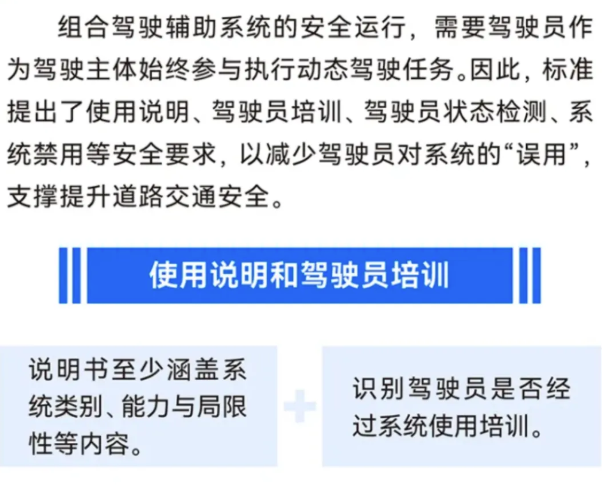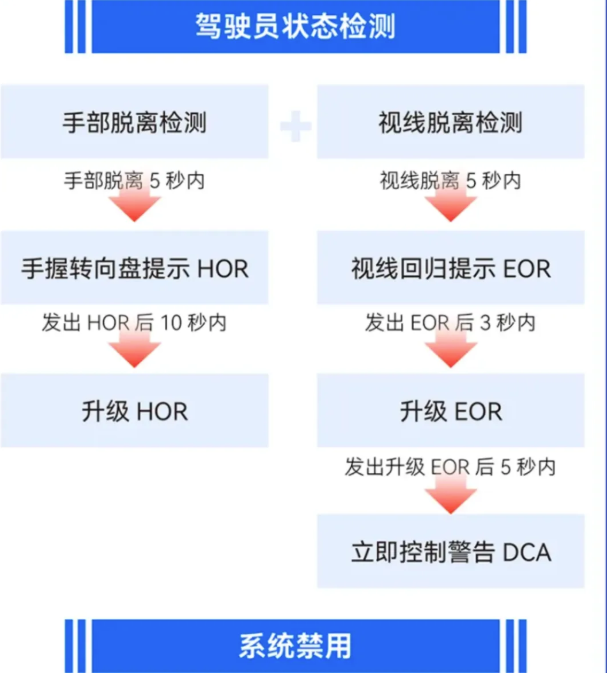Miit to introduce mandatory national standards to set safety threshold for autonomous driving technology
On September 17, the Ministry of Industry and Information Technology launched a public consultation on the mandatory national standard for "Safety Specifications for Intelligent Connected Vehicle Combined Driving Assistance Systems" (referred to as the "Mandatory National Standard for Combined Driving Assistance").
To prevent drivers from "improper use" or "over-reliance," the "Mandatory National Standard for Combination Driving Assistance" specifically points out that it is necessary to ensure that drivers have fully understood the system's functional limitations and operational specifications before activating the combination driving assistance system. This is to prevent traffic accidents caused by improper driver operation. The standard requires the system to verify whether the driver has received relevant usage training each time the system is started or the ignition is turned on, and the system can only be activated after confirmation.
According to industry experts, the introduction of this standard fills the gap in China's safety standards for combined driving assistance system products, providing important technical support for industry access, quality supervision, and subsequent issue tracking.
In an interview on "Zero View Automotive" live broadcast by China Business News, Ma Zhenshan, Secretary-General of the China Automotive Quality Committee, stated: "This actually reflects the country's long-term planning for the development of intelligent driving technology—leveraging our country's first-mover advantage in the electric vehicle sector while ensuring the stable development of this key technology. We must seek a balance between innovation and safety: we cannot miss development opportunities due to excessive caution, nor can we take reckless actions that lead to uncontrollable risks."

The system will be temporarily disabled due to the misuse of assisted driving.
We have noted that the "Mandatory National Standard for Combined Driving Assistance" has constructed a "threefold safety protection network" from the three aspects of "enhancing product performance," "strengthening safety guarantees," and "regulating usage processes," comprehensively standardizing the safety performance of combined driving assistance systems to improve road traffic safety levels.
The standardized use of intelligent driver-assistance systems has become a consensus among the industry and users. According to the clear classification in GB/T40429—2021 "Automotive Driving Automation Classification," a combination driving assistance system is not equivalent to an autonomous driving system. It does not have the capability to independently recognize and handle all events and scenarios during driving. Drivers still need to continuously monitor the vehicle's internal and external environment and actively participate in dynamic driving tasks to ensure driving safety.
To this end, the "Mandatory National Standard for Combined Driving Assistance" specifically emphasizes that to ensure the driver can maintain attention to the vehicle and external environment and continuously engage in dynamic driving tasks during system activation, the system must have hand-off detection and gaze-off detection functions. Once the driver exhibits hand or gaze-off behavior during system activation, the system should immediately issue reminders and alerts. If the driver does not respond to the alerts in a timely manner, the system should controllably exit the active state.
To ensure that drivers can correctly use the system, the standard stipulates that if the system executes risk mitigation functions due to driver disengagement, or after multiple instances of hand or gaze disengagement, the system will prohibit the use of the combined driving assistance system for a certain period of time.
At the manufacturing enterprise level, the "Compulsory National Standard for Combined Driving Assistance" not only sets safety operation limits for intelligent driving assistance systems but also requires car manufacturers to ensure that each function is safe and reliable through multi-dimensional, real-world testing and verification methods, thereby building a solid safety barrier for the product.
The "Mandatory National Standards for Combined Driving Assistance" strictly define the system's "design operating conditions," requiring the system to be activated only under these conditions. For different functions (such as single-lane, multi-lane, and navigation assistance), the standards set comprehensive safety technical requirements, including human-machine interaction, functional safety and expected functional safety, information security, data recording, and more. A multi-level verification scheme is constructed, including field tests, road tests, and document inspections.
For the pilot combination driving assistance system, to ensure that the system meets the expectations of other road users when performing dynamic driving tasks, the standard requires the system to have speed control assistance functions and explicitly stipulates that the system should not perform lane changes at solid lines and other operations. To ensure the system can recognize and respond to events and scenarios characteristic of China's road traffic, the standard is based on China's road traffic characteristics and constructs test scenarios including traffic environments such as road intersections, construction zones, roundabouts, and tunnels. To ensure that the system's declared capabilities are fully validated, the standard requires verification through at least field tests, road tests, and document inspections to ascertain whether the system meets relevant safety requirements.
To ensure the safe operation of the combined driving assistance system in complex and ever-changing real traffic environments and to systematically prevent various risks that may arise throughout the entire process from development and design to operation, the "Mandatory National Standard for Combined Driving Assistance" specifically proposes safety assurance requirements for the research, development, manufacturing, and usage processes of the combined driving assistance system.
In the development stage, strengthen safety risk design to "prevent risks in advance"; in the production and manufacturing stage, ensure production robustness and traceability to achieve "stable and traceable manufacturing"; in the usage and operation stage, dynamically monitor the vehicle's operational status to achieve "capable of monitoring and reporting". Promote the establishment and continuous operation of a scientific and comprehensive safety assurance system to comprehensively enhance the security of the integrated support system.
"The OTA upgrades for integrated driving assistance systems should also be carried out cautiously. They should not be rushed to market before the technology is mature, and users should definitely not be used as test subjects," said Ma Zhenshan. "This is not to deny the value of OTA, but to emphasize that upgrades should be prudent and appropriate, ensuring that each upgrade is safe and reliable."

"The mandatory national standard" has become an urgent need.
Currently, the global automotive industry is accelerating its transition towards electrification, connectivity, and intelligence. Intelligent connected vehicles, as the strategic high ground for the future development of the automotive industry, have become an important vehicle for cultivating new productive forces and a core driving force for industrial upgrading.
The integrated driving assistance system, as it can effectively reduce driving burden and enhance driving comfort, has become a highlight of new models in the market and an important reference factor for consumers when making a purchase.
A combined driving assistance system refers to a system that continuously performs lateral and longitudinal vehicle motion control of the dynamic driving task under its designed operating conditions. This system is composed of hardware and software with corresponding capabilities, which can adapt to the specific target and event detection and response requirements for lateral and longitudinal vehicle motion control.
According to statistics, in the first seven months of this year, the number of newly sold passenger vehicles equipped with combined driving assistance technology in China reached 7.7599 million units, an increase of 21.31%. The market penetration rate was as high as 62.58%, an increase of 6.5 percentage points compared to the previous year.
However, with the widespread application of combined driving assistance technology, a series of new problems and challenges have also emerged.
Due to the lack of unified product performance standards, the performance of various automobile manufacturers' combined driving assistance systems in complex road conditions, such as mixed traffic and road construction, varies significantly. This is influenced by differences in perception technology solutions, control strategies, and human-machine interaction logic. This not only may lead to users misunderstanding the functional boundaries and forming over-reliance but also poses potential risks to road traffic safety.
In the marketing process, there exists an issue of mismatch between marketing information and actual usage risks. Some companies exaggerate in their promotions, using misleading expressions such as "advanced intelligent driving" and "no takeover required throughout," blurring the lines between "driver assistance" and "autonomous driving," and ignoring the system's limitations. This leads some drivers to lower their guard, engaging in dangerous behaviors such as long periods of hands-off driving and distraction, which in turn causes traffic accidents, resulting in casualties and attracting widespread social attention.
"Safety is the cornerstone of intelligent driving. Life is priceless. The current mass-produced Level 2 driver assistance is not fully autonomous driving. If companies exaggerate its capabilities and claim it can be 'completely hands-free,' it will directly threaten user safety and must be strictly regulated," emphasized Ma Zhenshan.
Against this background, accelerating the establishment of safety baseline standards for combined driver assistance systems and clarifying the boundaries of promotion has become a common expectation and urgent need for regulatory authorities, the industry, and the public.
【Copyright and Disclaimer】The above information is collected and organized by PlastMatch. The copyright belongs to the original author. This article is reprinted for the purpose of providing more information, and it does not imply that PlastMatch endorses the views expressed in the article or guarantees its accuracy. If there are any errors in the source attribution or if your legitimate rights have been infringed, please contact us, and we will promptly correct or remove the content. If other media, websites, or individuals use the aforementioned content, they must clearly indicate the original source and origin of the work and assume legal responsibility on their own.
Most Popular
-

List Released! Mexico Announces 50% Tariff On 1,371 China Product Categories
-

EU Changes ELV Regulation Again: Recycled Plastic Content Dispute and Exclusion of Bio-Based Plastics
-

Mexico officially imposes tariffs on 1,400 chinese products, with rates up to 50%
-

Clariant Unveils Cost-Cutting Plan Details, Plans to Shut Down Multiple Plants
-

Nissan Cuts Production of New Leaf EV in Half Due to Battery Shortage






